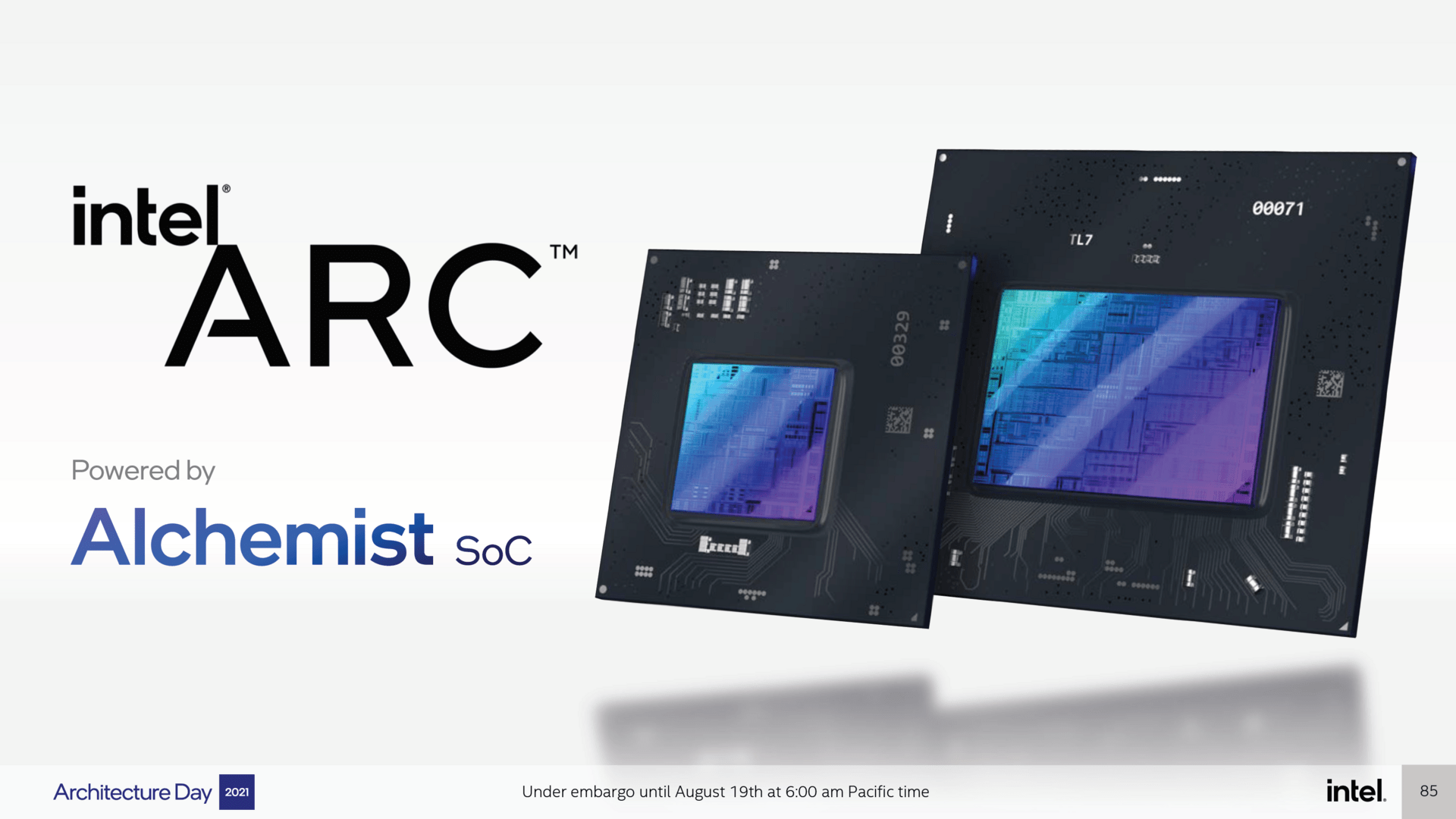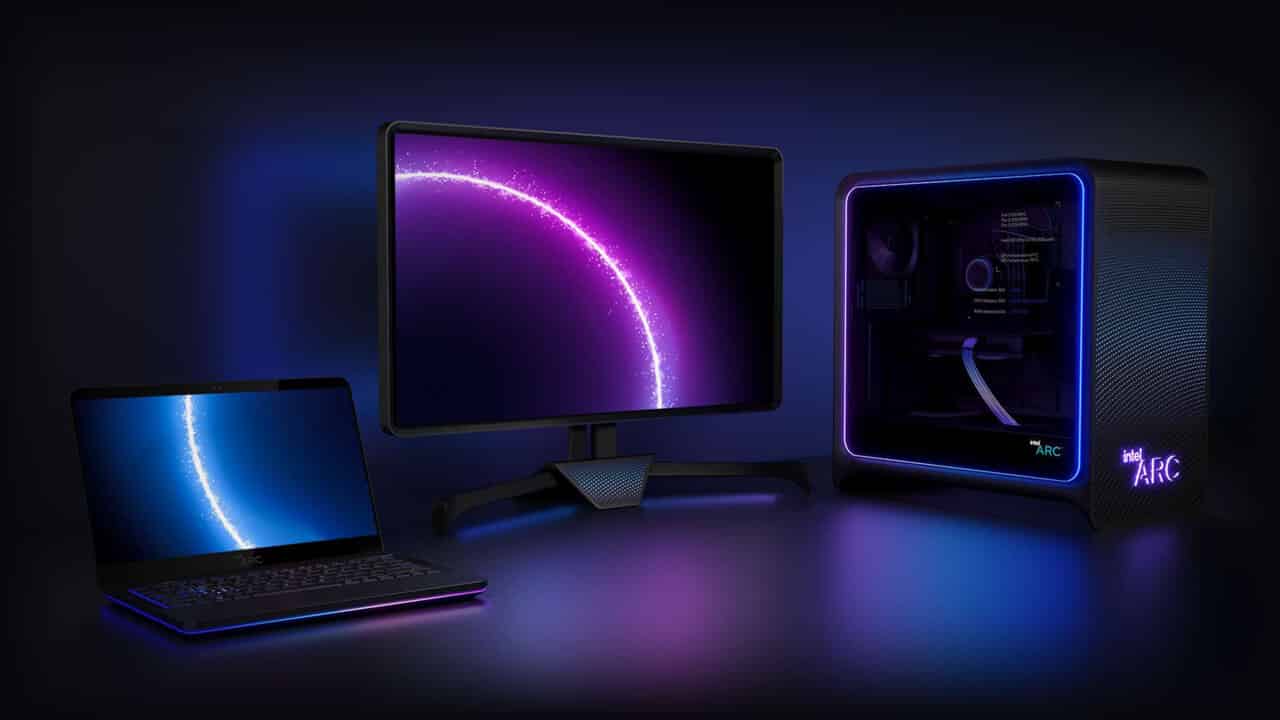Sunday question: Can Intel Arc already compete with AMD and Nvidia?
: Test |CUP | Specs |Config
AMD vs. Nvidia vs. Intel or Radeon vs. GeForce vs. Arc in the fight for the crown in graphics cards should still be 2022. But can Intel already keep up, or do players have to wait until the presentation of the following generations Battlemage, Celestial and Druid? How do you see Intel’s offensive?
Intel Arc: The starting position
Originally announced for the end of 2021, Intel had to admit in August of last year that the first products based on the Xe-HPG architecture, codenamed Alchemist, will be delayed. Intel’s discrete gaming graphics card for desktop PCs and notebooks will not be on the market until the first quarter of 2022 at the earliest, Intel said.
Just a few days later, at an event in Berlin as part of Architecture Day 2021, the manufacturer revealed further details about the GPUs of the gaming graphics cards from the first Intel Arc series and the new Xe Core based on the Xe HPG architecture.
Alchemist SoC with Xe cores and Vector engines
The heart of Alchemist alias DG2 is precisely this Xe-Core, which Intel called it for the first time. This Xe-Core is the equivalent of a streaming multiprocessor (SM) at Nvidia, a compute unit (CU) at AMD or a subslice according to the previous nomenclature from Intel.
- Intel Arc: Details on the GPUs of the gaming graphics cards
Among other things, the Xe core consists of 16 vector engines, which in turn are divided into 8 groups of 2 vector engines each and are supported by 16 XMX cores, Intel’s “tensor cores”, per Xe core.

Intel Arc with Alchemist (Image: Intel)
Bild 1 von 7
These matrix engines take care of accelerating matrix calculations and Intel’s own AI upsampling XeSS (more details), which should also run on graphics cards from AMD and Nvidia and compete with their solutions.
The manufacturer has not yet revealed what the Vector engines look like in detail. For example, Intel does not yet name the number of “execution units”, i.e. the total number of individual shaders in the engine.
RX 6800 (XT) and RTX 3070 (Ti) in sight?
The most recent rumors, which Alchemist attests to the performance of a GeForce RTX 3070 Ti when fully expanded, speak of up to 4,096 shaders and 512 execution units as well as up to 16 GB of GDDR6, which is said to be connected via a 256-bit wide memory interface.
- Intel Arc: Alchemist achieves GeForce RTX 3070 Ti in benchmarks
In the areas of “Half”, “Single”, “Double” and “Quad-Float GP Compute”, the calculation of floating point units with half, whole, double and quadruple precision, the graphics card achieves the performance level in the SiSoftware Sandra benchmark an Nvidia GeForce RTX 3070 Ti (test).
- Half-Float GP Compute: 35.093 Megapixel/s
- Single-Float GP Compute: 20.888 Megapixel/s
- Double-Float GP Compute: 1.000 Megapixel/s
- Quad-Float GP Compute: 109 Megapixel/s
In a direct comparison with the GeForce RTX 3070 Ti, the Intel Arc graphics accelerator that has now appeared scores almost 8 percent more points overall. The graphics card based on the DG2 silicon achieved a maximum clock frequency of 2.1 GHz in the floating-point calculations of the benchmark.
According to the specifications read out, the Intel Arc ran with a 12.8 GB video memory, which would speak for the 16 GB GDDR6, as previously suspected for the ARC top model. This is said to have been the full expansion “DG2-512”.
As always, the results should be treated with great caution, since on the one hand they may still have been prototypes and less a final product and the framework conditions of the benchmarks were not made public in detail.
Since an Intel Arc with 4,096 shader units and a clock frequency of 2.1 GHz achieves a raw performance of 17.2 TFLOPS, the Radeon RX 6800 (13.9 TFLOPS) and the Radeon RX 6800 XT ( 18.6 TFLOPS) as well as the GeForce RTX 3070 (20.4 TFLOPS) and GeForce RTX 3070 Ti (21.7 TFLOPS).
However, since the pure raw performance also has to be brought to the street by the architecture and last but not least by the driver in games, the performance of the Intel Arc graphics cards can hardly be assessed so far. However, the GeForce RTX 3070 was repeatedly mentioned as a possible indicator.
The full Arc portfolio based on the DG2 silicon for desktop PCs is expected to look like this, although the final specifications have not yet been fully communicated by Intel.
No more release in the first quarter?
While Intel only indicated a release for desktop and notebook in December 2021 and also provided the product page intel.com/arc with corresponding information, these have now disappeared again and Intel officially only speaks of “Coming 2022“. In many places, a release is no longer expected in the first quarter of 2022.
However, Intel confirmed the market launch after CES 2022 for the 1st quarter – but it is very likely that these will only be the first notebooks, the gaming PC models are in fact likely to follow later. On the other hand, Acer Germany had already promised a notebook with an Arc A370M at the CES – without Intel’s blessing.
Intel Arc: How do you see it?
The editors would love to hear your take on Intel’s upcoming release of discrete gaming graphics cards.
When does Alchemist (“DG2”) take the stage?
Out of “Let’s Play Q1 2022” and “Coming Q1 2022‘ now became ‘Coming 2022“, will Alchemist be released in the first quarter of 2022, or will players have to wait longer for a third player with the graphics cards?
In the first quarter of 2022
In the second quarter of 2022
In the third quarter of 2022
In the fourth quarter of 2022
Not at all in 2022
How do you rate the performance of Alchemist (“DG2”)?
The GeForce RTX 3070 is repeatedly mentioned as a potential opponent of the Intel Alchemist full expansion, but where do you think the top model of the first Arc series could end up?
Radeon RX 6900 XT bis GeForce RTX 3090
Radeon RX 6800 XT bis GeForce RTX 3080
Radeon RX 6800 vs GeForce RTX 3070 Ti
Radeon RX 6700 XT bis GeForce RTX 3070
Radeon RX 6600 XT bis GeForce RTX 3060 Ti
Radeon RX 6600 bis GeForce RTX 3060
Can Intel’s ecosystem, including drivers, keep up with AMD and Nvidia?
Will Intel already have the ecosystem around the Arc graphics cards completely under control by the time Alchemist is released and will it be able to offer a correspondingly good and stable driver and, with XeSS, a good alternative to the solutions from AMD and Nvidia?
Instantly with Xe HPG “Alchemist”
Short term with Xe² HPG “Battlemage”
Medium term with Xe³ HPG “Celestial”
Long term with Xe⁴ HPG “Druid”
The editors are happy about every vote cast on the current Sunday question and well-founded justifications in the comments on this survey in the ComputerBase forum.
You have ideas for an interesting Sunday question? The editors are always happy to receive suggestions and submissions.
Was this article interesting, helpful or both? The editors are happy about any support from ComputerBase Pro and disabled ad blockers. More about ads on ComputerBase.















